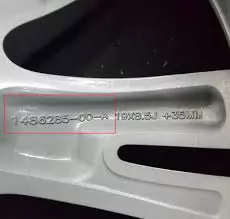What Is an OEM Part Number? Complete Guide Inside
If you’ve ever needed to replace a component in your vehicle or equipment, you’ve probably encountered the term “OEM part number“. This identifier plays a crucial role in ensuring you get the right replacement part. Whether you’re a DIY enthusiast, a professional mechanic, or an equipment manager, understanding the OEM part number is essential for accurate and efficient repairs. In this article, we’ll explore what an OEM part number is, its importance, how it differs from other identifiers, and how to locate it with confidence.
What Is an OEM Part Number
Definition
An OEM (Original Equipment Manufacturer) part number is a unique identifier assigned by the original manufacturer to a specific component used in vehicles, machinery, or equipment. It ensures consistency and compatibility across replacements.
Function
The OEM part number serves multiple vital purposes in the world of equipment and vehicle maintenance. First, it ensures that replacement parts are exactly the same as the originals, providing a precise fit and maintaining optimal performance. It also simplifies the inventory process for suppliers and technicians by offering a standardized way to identify and order components. Moreover, using the correct OEM part number minimizes the risk of installation errors, helps streamline maintenance workflows, and supports efficient procurement. Whether managing a repair shop or servicing your own equipment, knowing the OEM part number allows you to quickly source the right part without guesswork.
OEM Number vs Manufacturer Code
While the OEM part number is designated for a particular component by the equipment or vehicle manufacturer, the manufacturer code may refer to internal identifiers used by third-party part makers. These can sometimes overlap but generally serve different purposes.
| Identifier Type | Purpose | Assigned By |
|---|---|---|
| OEM Part Number | Matches parts to specific makes/models | Original Equipment Manufacturer |
| Manufacturer Code | Tracks production batches or internal records | Part Producer / Supplier |
Structure of OEM Part Numbers
OEM part numbers often follow a format unique to each brand. Typically, they combine letters and numbers to indicate part type, model, and version. For example, Ford may use “6L3Z-3280-B” to denote a specific driveshaft, where each segment has specific meaning regarding model year and fitment.
Importance of OEM Part Numbers
Precise Fit and Compatibility
OEM part numbers ensure the replacement part matches the original specifications of the equipment, eliminating risks of incorrect sizing, functionality, or failure.
Guaranteeing Product Quality and Reliability
Since OEM parts are produced or approved by the original manufacturer, they typically undergo rigorous quality control and testing.
Maintaining Equipment Performance and Value
Using OEM components ensures that the equipment or vehicle continues to perform as originally designed, preserving long-term value and minimizing downtime.
Streamlining OEM Part Number Lookup and Procurement
When sourcing a replacement, an OEM part number allows fast and precise identification of the right part. This prevents purchasing errors and simplifies ordering from suppliers or parts databases.
What’s the Difference Between OEM and Aftermarket Part Numbers
While both OEM and aftermarket parts may serve the same function, their part numbers and standards differ significantly:
| Feature | OEM Parts | Aftermarket Parts |
| Number Format | Assigned by the original equipment manufacturer | Varies by third-party vendor |
| Compatibility | Guaranteed match with original | May require adjustment or may not fully match |
| Quality Assurance | High, per OEM standards | Varies widely depending on brand |
| Warranty Coverage | Often included | Not always included |
| Cost | Usually higher | Often lower |
The difference between OEM and aftermarket part numbers lies in their origin, consistency, and reliability. OEM part numbers are created by the original manufacturer to match specific components in a product or vehicle. These numbers are tied directly to design specifications, ensuring exact fit and performance. In contrast, aftermarket part numbers are generated by third-party companies that manufacture alternative components, which may or may not perfectly align with the original specifications. While OEM numbers offer dependable compatibility and typically include a warranty, aftermarket numbers can vary significantly in quality, availability, and pricing. Although aftermarket options may be more budget-friendly and easier to obtain, they sometimes require additional verification or adjustments to confirm they meet the same standards as the OEM counterparts.
How to Find My OEM Part Number
| Method | Description |
| On the Part Itself | Look for engraved, stamped, or labeled number directly on the component |
| Through Your Vehicle | Use manuals or VIN to trace parts via manufacturer records |
| Documentation | Refer to parts catalogs, repair manuals, or technical drawings |
| Online Resources | Use OEM lookup websites or databases for cross-referencing |
| Consulting with Professionals | Ask authorized dealers or service technicians for confirmation |
Finding the correct OEM part number can seem challenging, but several reliable methods can help.
On the Part Itself
Many OEM parts have the number engraved, stamped, or labeled directly on the component. It may be found on flat surfaces, brackets, or along the edges. This is often the fastest and most reliable method for identifying the correct replacement.
Through Your Vehicle/Equipment
The owner’s manual, service booklet, or factory documentation often lists OEM part numbers. In many cases, your vehicle’s VIN (Vehicle Identification Number) can be used by dealers to look up the correct parts tied to your specific model.
Documentation
Technical drawings, repair manuals, and parts catalogs provide detailed diagrams and part numbers. These resources are especially useful for identifying internal or hard-to-reach components without disassembling the equipment.
Using Online Resources
Numerous websites offer OEM part lookup tools that let you search by model number, VIN, or equipment type. Many also include cross-referencing features to match OEM parts with equivalent replacements.
Consulting with Professionals
Dealers, service centers, and OEM-certified suppliers have access to manufacturer databases and can verify the correct part number based on your equipment details. This helps ensure accuracy and prevents unnecessary returns.
Conclusion
Understanding what an OEM part number is and how to use it effectively ensures you can maintain your vehicle or equipment with precision and reliability. OEM part numbers simplify the replacement process, enhance compatibility, and protect product value. Whether you’re performing routine maintenance or addressing unexpected repairs, always prioritize identifying the correct OEM part number for the job. With the right information and tools, sourcing high-quality OEM replacement parts becomes a seamless part of your maintenance routine.






